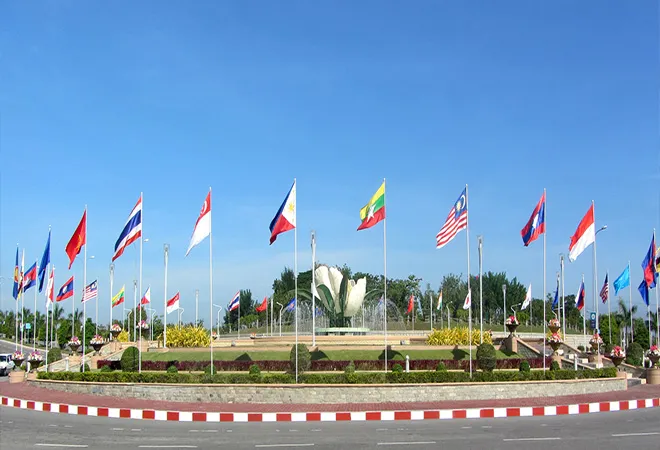
This week India will be hosting the heads of state or government of all 10 nations of the Association of Southeast Asian Nations (ASEAN) for the Republic Day celebrations in a dramatic declaration of intent by New Delhi to boost India’s ties with Southeast Asia. The year 2017 was an important landmark as India and the ASEAN commemorated 25 years of their partnership, 15 years of summit-level interaction, and five years of strategic partnership. The challenge now is to map out next steps in the India-ASEAN partnership at this time of unprecedented geopolitical flux in the wider Indo-Pacific.
There has been a sense of disillusionment on both sides about the present state of play in the relationship. While the ASEAN member states have been disappointed that India continues to push below its weight in the region, especially compared to its other Dialogue partners, New Delhi’s expectations regarding a more robust support for its regional outreach too have not been met. India’s capacity to provide development assistance, market access and security guarantees remains limited and ASEAN’s inclination to harness New Delhi for regional stability remains circumscribed by its sensitivities to other powers. The interests and expectations of the two sides remain far from aligned, preventing them from having candid conversations and realistic assessments.
Though Modi government’s ‘Act East’ policy is aimed at enhancing India’s strategic profile in East and Southeast Asia, New Delhi’s main focus remains on South Asia and the Indian Ocean region. There has been a shift in emphasis, of course, with India moving away from SAARC to BIMSTEC and asserting its centrality in the evolving geography of the Indo-Pacific. But it is no match for China’s regional profile which is largely about viewing Southeast Asia as its backyard. India’s economic focus too is not in tune with other regional powers which view ASEAN as an important market for their exports and investments. India’s export sector remains weak and the government’s focus has shifted to boosting manufacturing domestically.
India’s interest in ASEAN as a multilateral forum remains lacklustre as it continues to privilege bilateral partnerships to further its own interests. As New Delhi’s gaze shifts to the Bay of Bengal, Myanmar and Thailand have emerged as key players in its southeastern outreach. The hope is to use these nations as a bridge to the ASEAN. The temptation to prioritise these countries over others at the ASEAN may also prevent others from looking at India as a regional stakeholder. New Delhi is signalling, perhaps inadvertently, that it is more interested in becoming a member of various regional organisations because of global power credentials even when its substantive engagement with such platforms remains limited.
It is important for India and the ASEAN to chart out more operational, though modest, agenda for future cooperation. The three Cs of commerce, connectivity and culture have been highlighted but a more granular perspective is needed in terms of a forging a forward looking approach. There is no getting away from enhancing trade and economic linkages between India and the ASEAN. The areas where the two need to focus should be new ones like digital technologies where physical connectivity doesn’t really become prohibitive. India is fast emerging as a major player with significant comparative advantages in this realm. As Chinese digital giants begin to dominate the digital space in Southeast Asia and concerns rise about their ability to own data, Indian IT sector may take some advantage of a seeming reluctance of ASEAN states to put all their eggs in Chinese basket. India as a facilitator of the ASEAN wide digital economy will not only challenge China on its own turf but will also emerge as an economic guarantor of its own.
Economic engagement will need better connectivity between India and ASEAN than what exists today. Instead of talking about ASEAN wide connectivity projects, New Delhi now needs to focus on more effective delivery of projects it is already committed to. In this context, prompt completion of the India-Myanmar-Thailand Trilateral Highway, which will run from Moreh in Manipur to Mae Sot in Thailand via Myanmar, is key. The plan is to extend this highway to Cambodia, Laos and Vietnam in an attempt to project India’s role in the emerging transportation architecture in the region. With China having three times more commercial flights than India to Southeast Asia, improving air connectivity between India and the ASEAN should also be high on the agenda. In the maritime domain, the Bay of Bengal can be used as an exploratory ground for the development of an India ASEAN maritime framework.
Finally, the cultural connect between India and the SSEAN needs strengthening if more stakeholders are to be brought in. While India is offering scholarships to students from ASEAN states to study at the Nalanda University, this initiative should be broadened to include our front ranking institutions such as the IITs and the IIMs. India needs to engage with the best and the brightest of the ASEAN who will drive the regional policy in the coming years. New Delhi is giving more attention to cultural diplomacy in the ASEAN but still only three countries in the region – Indonesia, Malaysia and Myanmar – have Indian cultural centres. Tourism can be further encouraged between India and the ASEAN with some creative branding by the two sides.
While India and the ASEAN have been very ambitious in articulating the potential of their partnership, they have been much less effective in operationalising their ideas. The need now is to be focus on functional cooperation and make the idea of India-ASEAN partnership more exciting.
(An earlier version of the article appeared in The Hindu)
The views expressed above belong to the author(s). ORF research and analyses now available on Telegram! Click here to access our curated content — blogs, longforms and interviews.




 PREV
PREV


